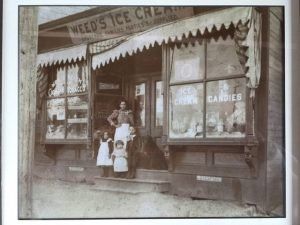Sweets!
I have a MASSIVE sweet tooth. I am frankly not too discerning either. Chocolate is, of course, high on my list. One year when I was young, Santa Claus brought my Dad a small antique wooden box with a lock in it. It was FILLED with chocolate; in particular chocolate covered cherries, one of his most favorites, and Andes Mint Candies. The thing is, my Dad didn’t lock the box . . . My Mom still to this day takes fiendish delight in roasting me over the fact that she caught me leaving their room with my mouth stuffed with chocolates – think chipmunk. My Mom, “Jascin are you eating your Father’s chocolate?” A maybe six or eight year old me, “No, Mommy.” Think of that through the guise of chipmunk cheeks stuffed with chocolate that was also likely dribbling down my chin and out the corners of my mouth!
I definitely got the sweet tooth from my Dad – who got it from his grandfather also known as “Big Daddy” – a name my Dad gave him as a child. I won’t get started on Mama Minnie, Big Daddy’s wife and my great-grandmother. Yes, my Dad was from an Italian family in case you didn’t note my maiden name is Leonardo! But, I digress. My Dad and I would sometimes eat two desserts – you know an hour or so after the first one and at about 9PM. He would say, “I think there is some nice gelato in the freezer.” By that point, I was a woman in my 40s.
But I also think my sweet tooth – because I love pure sugar candy too like Smarties and my Dad did too – comes from my Other Other Nana (read great-great grandmother) who you see in this image. She came from Germany in the late 1800s. She spoke no English. She married a young man also from Germany whom she met in New York City. They were a town apart in Germany but never knew one another. They had a family and lived in Brooklyn where she ran a candy and confectionery shop that you see her standing in front of – Weed’s Ice Cream – which also sold tobacco. Go figure. She stands out front – note the dirt road even in Brooklyn about 1900 or so – with my Other Nana (the girl with the messy hair – guess I inherited that as well), Helen, her sister, Elsie, and their brother, John, as well as the family dog. Yes, we are still a dog family. So, I come from a family that ran a sweets shop! And later, my Other Nana would marry a man who was a pharmacist and what did you find in pharmacies in those days? Candy and ice cream!
But I also think my sweet tooth – because I love pure sugar candy too like Smarties and my Dad did too – comes from my Other Other Nana (read great-great grandmother) who you see in this image. She came from Germany in the late 1800s. She spoke no English. She married a young man also from Germany whom she met in New York City. They were a town apart in Germany but never knew one another. They had a family and lived in Brooklyn where she ran a candy and confectionery shop that you see her standing in front of – Weed’s Ice Cream – which also sold tobacco. Go figure. She stands out front – note the dirt road even in Brooklyn about 1900 or so – with my Other Nana (the girl with the messy hair – guess I inherited that as well), Helen, her sister, Elsie, and their brother, John, as well as the family dog. Yes, we are still a dog family. So, I come from a family that ran a sweets shop! And later, my Other Nana would marry a man who was a pharmacist and what did you find in pharmacies in those days? Candy and ice cream!
So, while genes play a role in my sweet tooth, I think pure illustration or demonstration does too. My son, who is adopted, is already all about the ice cream after dinner like Big Daddy was. He is discerning however so maybe we will be in good shape. I would have loved to take him to the Sweet Shop here on island which is long gone – but he’s already been introduced to sitting at the pharmacy counter at Island Pharmacy and quick licking a cone from the Juice Bar!
You may ask, “Did Maria have a sweet tooth?” I have not seen anything in her journals that would lead me to that conclusion though you also have to remember that those were quite a bit more few and far between – a real indulgence then. Sweet shops and confectioners did pop up on the island; in fact there was a small one by the Atheneum but I believe later than when Maria was librarian there. Now, next time, ask me about Maria and beer.
JNLF
Recent Posts





